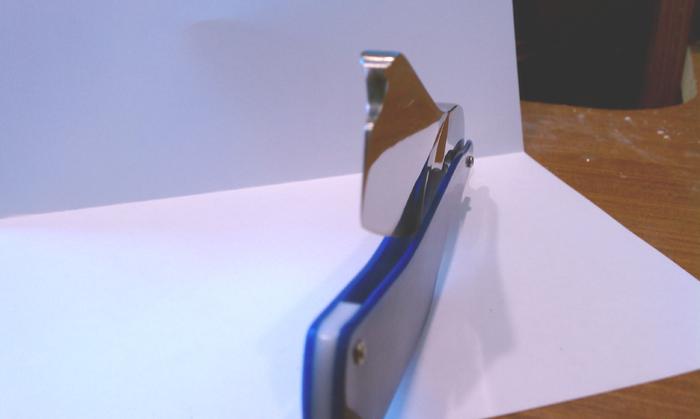Results 31 to 37 of 37
-
08-03-2011, 02:19 PM #31

Very nice work Kenny. Would you by chance have any pictures of the process, directed more towards the hand forging work?
-
08-03-2011, 03:41 PM #32

That is a gorgeous beast of a razor! Wow!
I'm also curious about the spine's width, though. Looks like a huge difference between this one and the spine on this 10/8 you posted a while back:

How come they can vary that much?Last edited by northpaw; 08-03-2011 at 04:06 PM.
-
08-03-2011, 06:29 PM #33

one word.....WOW!!!!
-
08-03-2011, 08:43 PM #34
-
08-04-2011, 03:01 AM #35

Hello Northpaw,
I certainly do appreciate your kind remarks on this razor and your great question. About the spine width. Infidel is correct on his comment concerning dies or such since I grind all my blades free hand on stones. I don't recommend this, just how I got started. I'm sure in due time I'll likely get a 2x72 built. I did pick up a hardness tester lot too long ago so I'm getting a little further out of the dark ages. lol. However, the thickness of the spine and blade design in this case, was long train of thought on my part. (Maybe too long!) Anyway, my goal was to make what by most standards is considered a huge razor, to a weight level that is not "over the top". Though unorthodox and perhaps a considered by some a no,no, I decided to use steel choice and a narrower spine as means by which I might shave this weight. Thought process being, I could achieve proper hardness with increased durability/strength, get a good hollow, thin edge and minimal flex at the blade. I have worked with A2 steel on knives and have had a good experience with the steel itself. (Of course knives are whole nother ball game but the steel type and qualities were what I was after) I did have to take into account that this narrow spine would ultimately place the blade outside the bounds of the traditional 4:1 ratio which produces perhaps something close to an 11 degree bevel set +/-. I do realize that these ratios may not be considered absolute by all standards and that there are most likely are some mathematical variances to these ratios when dealing with a smile or different razor shapes... but they are what I have been taught to be a good reference so I do consider them "pretty important'. That being said, I assumed that I would not likely be able to have my cake and eat it too. So, I chose weight reduction knowing that I would need to make up for the spine thickness in the honing process which I was able to do without too much fuss. Chose A2 to give me that little extra umph in strength. Anyway, these were my thoughts going into it and this razor is what popped out. LOL. On a side note, I am not by any means justifying my choices here, they were just choices I made in this case.
Best Regards
Kenny
-
The Following User Says Thank You to rangerdvs For This Useful Post:
northpaw (08-04-2011)
-
08-04-2011, 03:26 AM #36

Hello CTKnife,
I'll be forging another blade in the near future so I'll definitely try to get some taken on the next go round. Presently I am using a double Venturi burner gas forge that I built. I do a little pattern welding when I'm not working on razors, so I needed to have something capable of achieving welding temps. Presently I have a couple of old anvils a Peter Wright 1 1 7 and an old junk Hayden. Just got the Wright a few months ago and really like it compared to the old one. So, a basic set up as the forging goes. I certainly would not mind building a Power Hammer at some point but have not gotten around to it. I see from your avatar there, you may do quite a little forging. Any preference on the Blown vs Venturi? I really like the latter, seems to keep the scale down some but that may just be a matter of opinion or experience. Anyway, I'm getting off track, I'll see what I can do on some pics. Thanks for the inquiry!
Best Regards
Kenny
-
08-04-2011, 06:44 PM #37


 16Likes
16Likes LinkBack URL
LinkBack URL About LinkBacks
About LinkBacks






 Reply With Quote
Reply With Quote


